
| WWT Shows | CLICK TO: Join and Support Internet Horology Club 185™ | IHC185™ Forums |

|
• Check Out Our... • • TWO Book Offer! • |
Welcome Aboard IHC185™  Internet Horology Club 185
Internet Horology Club 185  IHC185™ Discussion Site Main Page
IHC185™ Discussion Site Main Page  Horological Discussions, Questions and Answers
Horological Discussions, Questions and Answers  European Pocket Watch Forum
European Pocket Watch Forum  Swiss Pocket Watch Question
Swiss Pocket Watch Question
 Internet Horology Club 185
Internet Horology Club 185  IHC185™ Discussion Site Main Page
IHC185™ Discussion Site Main Page  Horological Discussions, Questions and Answers
Horological Discussions, Questions and Answers  European Pocket Watch Forum
European Pocket Watch Forum  Swiss Pocket Watch Question
Swiss Pocket Watch QuestionPage 1 2
Go  | New Topic  | Find-Or-Search  | Notify  | Tools  | Reply to Post  |  |
I am trying to find out information on my grandfathers pocket watch. It is a silver hunter, 6 jewel, dated from the 1860's, and a key wind. the only markings are the serial numbers on each piece #23890 and on the back (Cover that exposes the back of the movement) there is "Jules Reynau" then "Geneva". I have been told that the movement is Swiss but I am now thinking this watch may just be anonymous. Thanks, 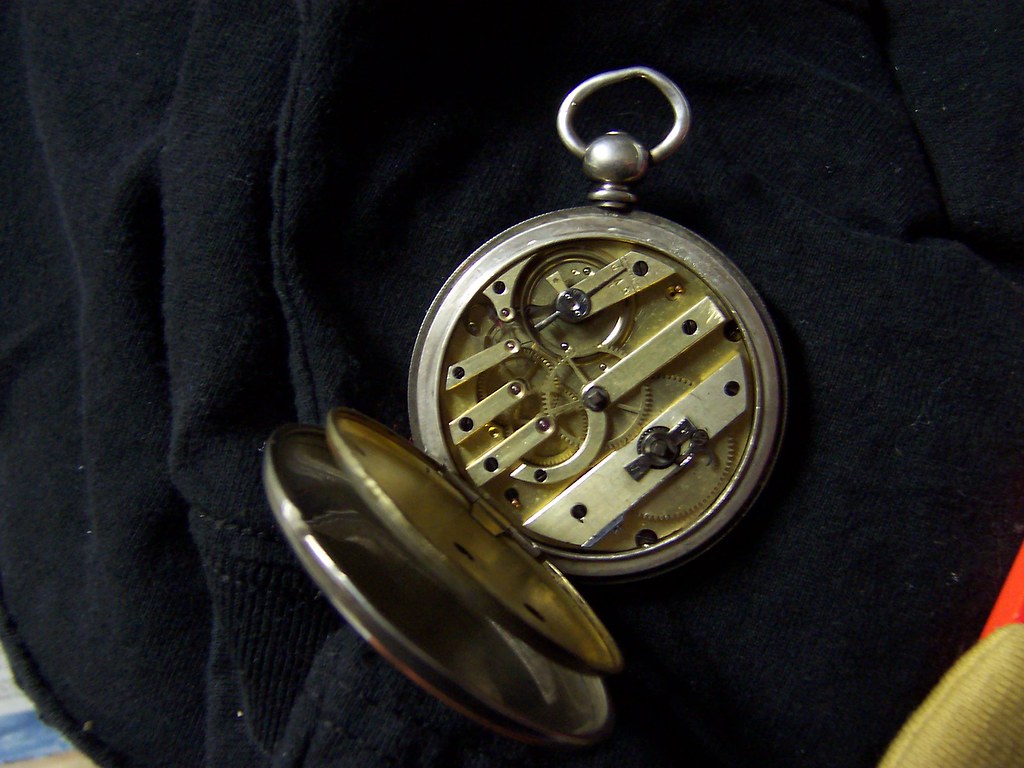 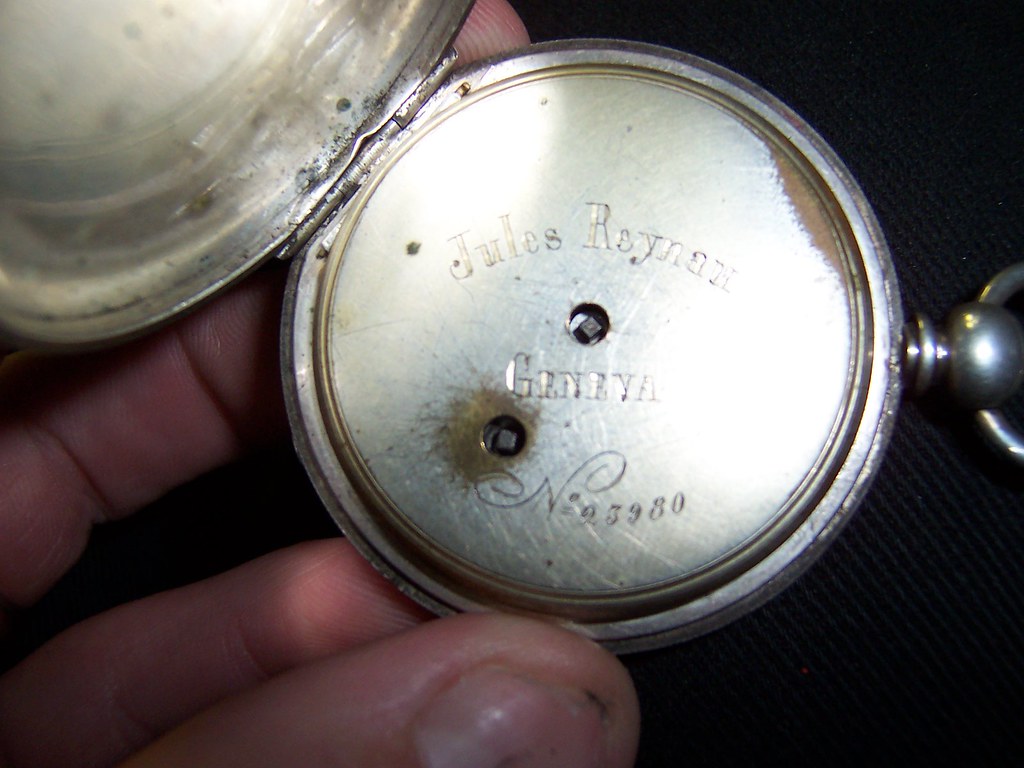 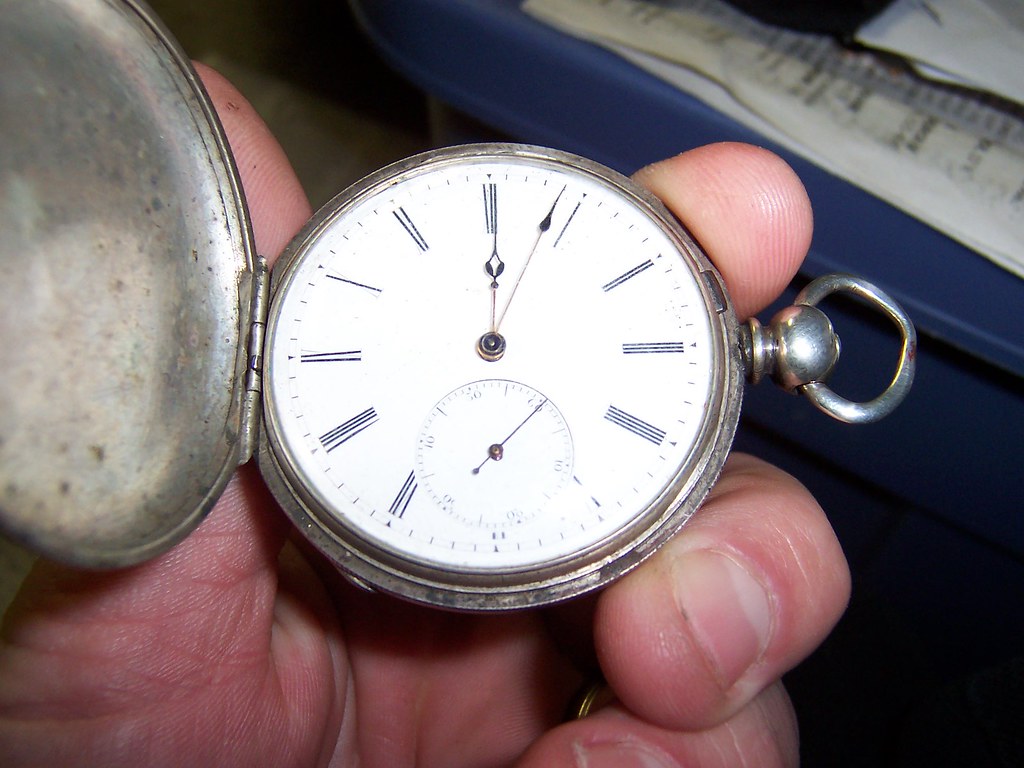  | |||
|
| Life Achievement Military Expert |
Thank you for posting the excellent pictures of your pocket watch. From the picture, it appears to have either 11 or 15 jewels, most likely 15. There is no "Jules Reynau" listed in Swiss Timepice Makers, by Pritchard. The closest listing is for a Jules Reymond in Geneva, cir. 1830. But I don't think your watch is old enough to have been made by him. The above watch is a rather common Swiss bar type from about the 1860-1880 period. These were produced in the Swiss cottage industry of the time. They were cased and finished by various shops big and small. Often, Swiss watches were purchased without names by wholesalers, thus the name on the covet (inner cover) was often not the maker of the watch but someone in the chain of sale. It was also common practice back then to put the names of famous French and English watchmakers on average Swiss watches to fool people; So at least we can see that your watch has always been an honest one! These watches were at one time extremely common and widely used in the U.S. Best regards, Greg. | |||
|
Jason; Your photography is good, but my eyesight is not what it once was. However, there may be a few things that I can relay that might be useful. In keeping with what Greg has already said I would add that your watch has what is called a Lepine calibre (named for Jean-Antoine Lepine). It employed “bars” rather than a top plate to reduce the overall thickness of the mechanism. The balance wheel is not split and contains no timing screws. The wheel itself appears to be made of round bar stock (possibly of low karate gold). Until 1840 or so most bimetallic balance wheels were only used in the most expensive mechanisms - it took considerable time for the round bar stock balance wheels to totally disappear from production. Unlike Greg, I am not totally certain about the jewel count and lean more closely toward an even count like 6, 8, 10 etc for the reason that the escapement appears to be a cylinder type. Is there more that you can tell us about how your grandfather obtained the watch? - Mark Lee | ||||
|
| IHC Life Member RR Watch Expert |
Mark, To me this does not appear to be a cylinder escapement. The shortest 'bar' that comes out at right angles to the three parallel bars holds the pallet lever. The five 'bars' starting from the long one (which is actually a bridge) going through the center of the movement, hold the 2nd wheel, 3rd wheel, 4th wheel, escape wheel and pallet fork, respectively. I concur that the movement is an 11 or 15 jewel movement. Ed Ueberall IHC Member 34 The Escapement | |||
|
Hi Jason, Many thanks for posting this thread and in particular the photo's of this watch - certainly made me sit up!. If I may add my 2 penn'orth to the thread .... As Greg and Mark have stated it is a bar movement, which was and still is commonly available simply because it was the style 'in vogue' during that period of Swiss manufacture and of which huge numbers were produced. However, any similarity of you watch to the 'common' bar movements of that period frankly ends there, as they were predominantly equipped with cylinder escapements, which yours is not!! Your watch appears to be a 15 jewel movement, but may be jewelled to the centre arbour also - but you'd need to remove the dust cover to find out. What is particularly Unusual about your watch, is that it appears to be equiped with a counterpoised, jewelled side lever escapement - and I strongly doubt you will find very many of those around! Trust me, I've been looking for quite a while for such a movement and haven't turned up one single example, not even later 3/4 plate movements. Of around the 100 or so bar movements I've sorted through in my collection(loose and in watches), all except half a dozen have been equipped with cylinder escapements. Of the other half dozen, which Do Have side levers, all have one piece polished steel pallets - and none of them jewelled - even with inserted slips. If you read my thread on the H.White pre WW1 military pocket watch, I've been searching since posting that thread for an escapement similar to your watch, to either copy or use as a donor and have also contacted quite a few professionals for advice. Although my watch uses a later 3/4 plate freesprung movement, it appears to have been in the process of conversion from an English lever type to a Swiss lever (has a club tooth escape wheel). Because of the quality and proposed use of the movement, professional opinion is that counterpoised jewelled sidelever pallets would have been used rather than steel, and the conversion was to eliminate fiddly and difficult repairs to the English lever escape wheel, which resembles the Graham Dead beat wheel in tooth shape. Even the 3/4 plate sidelevers I have turned up including Longines examples, use steel pallets albeit with jewel slip inserts! So, seems quite a good quality movement manufactured with an escapement to a standard well outside the norm for the period, as such seems very unusual not to be signed - may be something behind the dial to identify it. The name on the inner dome is probably that of the retailer, or possibly an importer depending upon the assay marks. Another feature of your watch is the barrel bridge, which is stronger than the usual offerings of that period. This is a real 'Achilles heel' of bar movements, because in addition to being very thin in the area over the barrel, most bridges are significantly cut away to accommodate the ratchet right next to the barrel arbor - and they're not bushed. Consequently, they wear horrifically at that point and can (and do) snap in two. Extreme care needs to be taken in their repair too due the their fragility and lack of material around the hole. It's not uncommon to find that due to wear and consequent 'tilting' of the barrel, the teeth on the barrel have gouged such a groove in the underside of the bridge, they're almost sawn in half! Your watch appears to have the ratchet on top of the bridge so retaining valuable 'meat' around the hole for the barrel arbour. It probably also has some variation of 'Geneva' stopwork on the other side of the mainspring barrel to prevent overwinding. The wear on the case suggests it has been a well used and loved timepiece, I hope you will continue using it too for many years to come. Best regards John | ||||
|
Hi Jason, Can you tell me if you have any photos, of the Trademarks or markings on the inside of the case, other than the one shown? I have a large number of Trademarks and Makers Marks, that I can look through for you, if you can post a photo of it, or tell me what they look like. Letters are important too, so post any of those if they are present. I have a few of these that are similar to yours, and it's really interesting to see what everyone posts about these watches, and learn the differences and similarities. With information like this, I can use the information to figure out things about my watches too. It always starts with just this kind of question, to eventually get to know more and more about our unique and previously unknown watches. I just love that. Thank you for the question. It's funny, that it's in the search, with a lot of different answers, that I learn so much about so many of my watches. Especially when they are different points of view. I do love to see the pros adding all of their thoughts about a watch, you always get so much more information, when they are weeding out, and adding to, what they know about a watches history, and their experience with them. This is real Horology. Keep it up guys! Sheila | ||||
|
Jason; I stand corrected and by two people by whom I am pleased to be corrected. Ed and John have both relayed some exceedingly interesting and detailed information. Like Sheila, I too would be interested in viewing any other photos of the watch that you have. Hallmarks are indeed interesting. - Mark Lee | ||||
|
Mark, thankyou for your generousity of spirit, but truly no need to feel corrected by me standing or sitting I'm taking an educated guess at the jewel count anyway. Cylinder escape wheels are easy to spot even if you can't see the arrows, because the wheel is always without excepion, halfway under the balance rim, as the darts have to enter the cylinder which is central to the balance. Apologies to all if I appear to be telling granny how to **** eggs here, it's just to help those unfamiliar with the escapement to recognise it. In the spirit of 'A picture is worth a thousand words', I've posted below some photo's of the Geneva stopwork for those that have never seen it And, the Infamous barrel bridge that haunts these movements to illustrate what a lousy contraption it was (is)!. One point I forgot to mention with those things, is that the mainspring barrel is Only supported by the top of the bridge, it has No bearing, Bridge or cock of any description on the underside as you can see in the photo, hence the excess wear and sawing of the bridge in half!. Later movements have the dial plate fully across that area and a pivot hole bored in it. Another weak point on these movemnts is actually the stopwork, as the 'Tit' breaks off the driver on the barrel arbour! This contacts the slots in the 'Maltese Cross'turning it on each rev of the barrel, once the large 'wedge' goes full circle and hits the other side of the driver, it locks the mechanism ....... of course, then as now, there's always some gorilla at hand to 'push the envelope'....! John 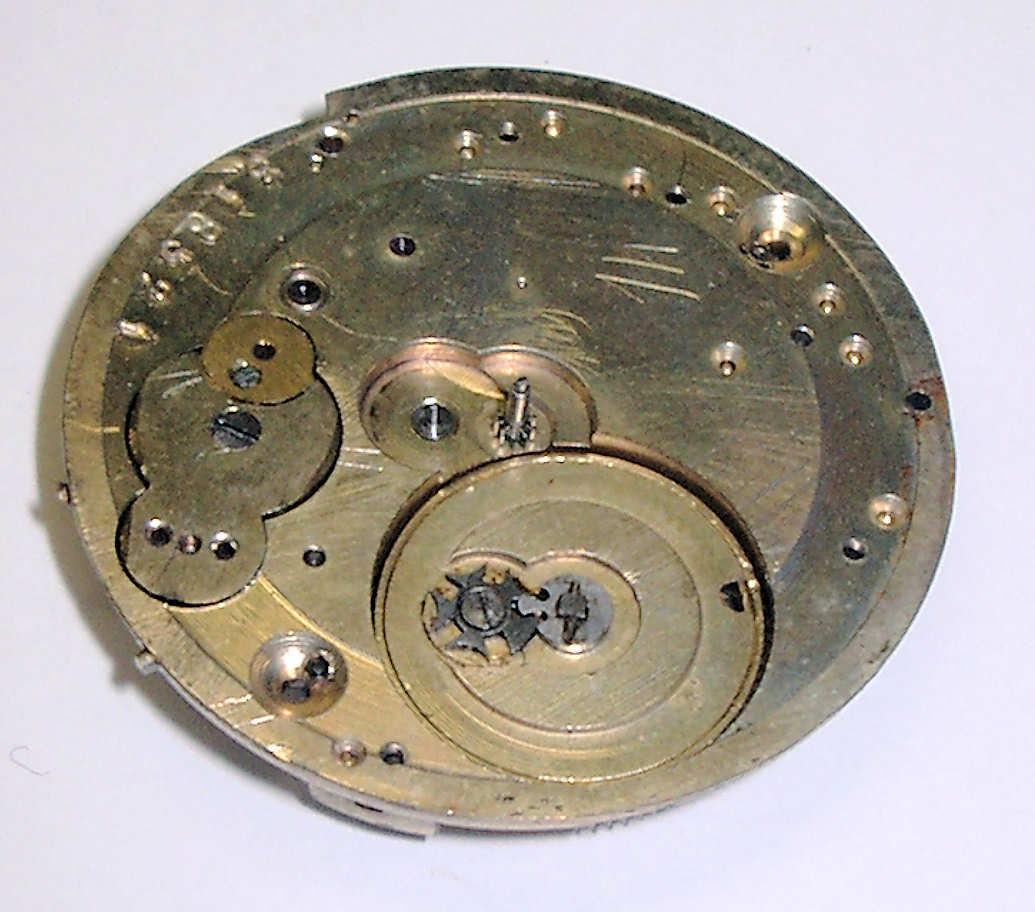 | ||||
|
This illustrates just how flimsy the bridge on this type of movement really is. It doesn't take much imagination to understand what an almightly pig they are to repair! The pivot hole in this bridge is 2.2mm diameter, and the remaining lip of metal between the ratchet tooth and pivot hole is ......0.3 mm! John. 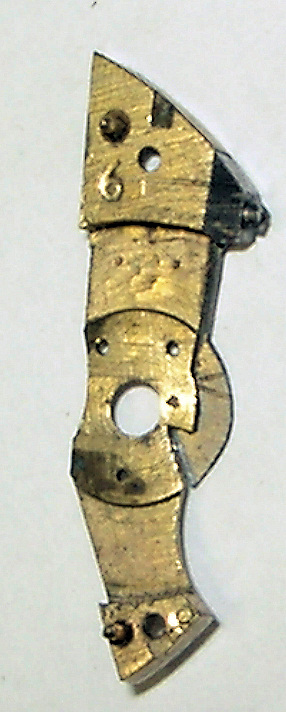 | ||||
|
Side shot of the same bridge, it's actually 0.65mm at the centre ......not a lot of meat to secure a bushing .... if you dare broach the hole out to take one ........ and they bend and break sooooo easily! John 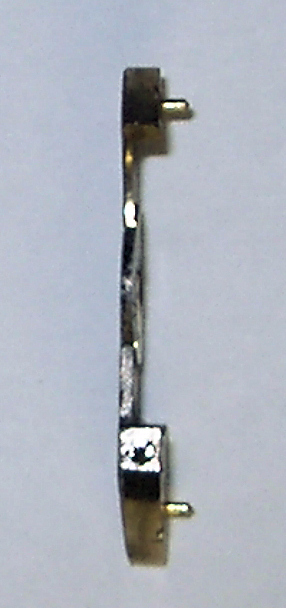 | ||||
|
This shot shows the top of the bridge without the dust cover for the key shaft, and is representative of the majority of Swiss bar bridge movements you are likely to come across. You will no doubt feel relieved to know Jason, that your watch probably has a lot more meat around the pivot hole than this specimen (which isn't actually too badly worn)!. Hope the photo's are found to be helpful! Best regards John  | ||||
|
| IHC Life Member |
You guys have been having so much fun with Mr. Lane's watch, I thought I would let you dissect a watch I have with a similar looking movement. | |||
|
Hello Ethan, thanks for posting the photo, Looks like a common ebauche being used in those days, which was kitted out by whichever maker was buying them in. Shame many of them are un-named. I never like to think of watches as being anonymous, as some old boy somewhere (or even a young one) spent hours slaving over each one to create them! Your watch has a Swiss sidelever escapement too, but appears to have polished steel one piece pallets rather than jewelled. Balance looks like an uncut mono-metalic type with timing screws and a flat hairspring. I'd be interested to see the balance on Jason's watch ............ if he can be persuaded to let it stop and take a shot of it It may even sport a Breguet overcoil if he's lucky! Regards John | ||||
|
| IHC Life Member |
John, I agree with your assessment. This watch is in a pretty 18k hunting case. Its cuvette reads "Henry Courvoisier & Co., Geneva, Detach'd Lever. 15 jewels, #14847." The dial is unsigned. Whatever the movement's design shortcomings, it runs well and fairly accurately. | |||
|
John; Tell me more, tell me more - how can I learn if I cannot 'pick' your brains? Looking at Ethan's watch I can make only a few observations. As you have pointed-out, the mechanism has a flat, monometallic balance that is not cut, but do I detect that it is a three arm rather than a two arm wheel? Another thing which appears to be unusual is that the screw heads at 8 o'clock and 2 o'clock appear to be "pinned". Is this any kind of normal procedure and if so, what was it intended to accomplish? - Mark Lee | ||||
|
| IHC Life Member RR Watch Expert |
Mark, The "screw heads" protruding through the pillar plate are there to lock the dial pins in place so that the dial will not loosen from the pillar plate. The dial pins are soldered to the dial and go through the holes in the plate at 2 and 8 o'clock. Each pin has a small notch located a little away fron the end of the pin. The dial screw has a round flange at its base with a semicircular notch cut into the rim. When the notch is aligned over the hole in the plate, the dial pins will fit through the hole. The dial screws are then unscrewed slightly so that the flange pushes up against the top of the dial pin notch, thus keeping the dial attached. Its really quite a clever arrangement and allowed the dial to be removed from the movement without having to remove the movement from its case. Ed Ueberall IHC Member 34 The Escapement | |||
|
John - most of the Swiss bar movements I have seen with side-lever escapement DO have jewelled pallets, but the jewels are often not visible unless you look closely. They are set in horizontal slits in the pallet. From the top they look like plain polished steel. This counterpoised fork is from a movement nearly identical to Ethan's. 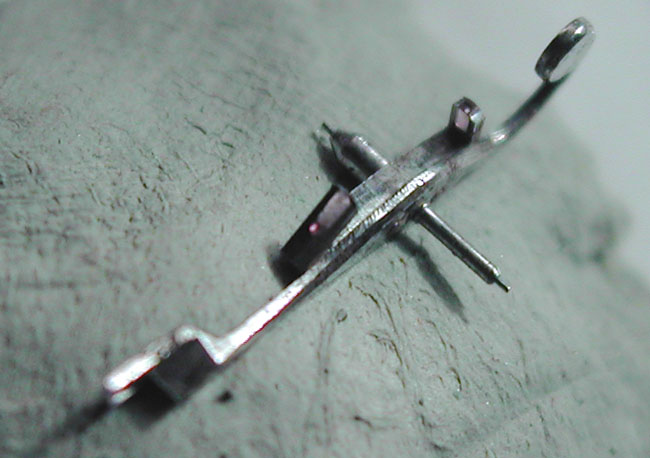 | ||||
|
Mark, that enthusiam of yours comes bounding right off the page ....brilliant!, and you're welcome to pick my brains anytime..... so long as you leave me some over to do useful work with The copper pins you can see are as Ed states, soldered to the back of the dial, and the screws next to the pins lock them & therefore the dial in place. You will also at some point find on older movements, a separate brass dial plate on the movement to which the dial Is secured by taper pins, the whole thing including dial then secured to the movement by taper pins also. Others still, may have retaining screws into the side of the dial plate. If I may enlarge on the dial screws, it may help prevent the unwary having accidental disasters with (possibly very rare and expensive) enamel dials! The screws which Ed talked about are indeed notched on one half to clear the pin and allow it's entry through the dial plate. The screw heads usually have a sharp edge ground on them for the remainder of the edge, which bites into the copper pin as the screw is rotated. Now, the dial screws are actually 'Unscrewed' from the dial plate in order to clamp the pin and lock it. Obviously if you continue to unscrew them, they will move further away from the dial plate - and pull the pin harder due to the mechanical efficiency of the threads. If you continue to screw them out, it will force the pin further away from the copper backplate to which the enamel is fired as the dial can't go further than the movement plate it's actually sat on. If you're lucky, you could reach the cut away side of the screw head again as it rotates before any damage is done to the dial (or strip metal off the pin) - and the pin will be released. If you're unlucky (usually) the pin will either tear off and / or distort the plate ..... and a big lump of that treasured dial will fall off directly over where the pin is (was) soldered ..... along with creating some very not so nice hairlines! When the dial screws are tightened (Remember - actually 'Unscrewed'), you only need sufficient force to pull the pin and dial until the dial is nipped to the movement and No More! Also make sure the holes for the hands are central to the pivots. When Removing a dial, Always 'Tighten' the dial screws INTO the movement until the flat clears the pin, Never Ever 'Unscrew' them even if the clearance flat is near the pin, you'll probably break the dial! The balance does in fact have 3x arms, but you may see a variety of forms on these things, some castings, some turned from solid, 2 arms, 3 arms, flat or round. I'm just a 'mechanical enthusiast' rather than a historian, so not sure when the Swiss started using materials and designs that compensated for temperature changes. You may even come across examples which have a much later compensation balance than the age of the watch would suggest - just as verges were modified to lever escapements. Doesn't mean a watch is a fake, could just have been a 'modern repair' even if 100 years ago! Jerry, fantastic shot of the pallets, can't get them that crisp with my camera (4.0MP Pentax Optio 430RS) what's the secret? The jewels shown are the 'Slips' that I mentioned earlier in the thread, so it's great that you've posted an example here. If you take a look again at Jason's watch, the pallets are actually full jewel stones, not slips - and that is very uncommon for that or even later movements of that type. The problem with those steel pallet arms is they're fiddly and expensive to repair and (relatively) heavy. Coupled to the length and weight of the lever, this gives the roller jewel a hard time unlocking the pallets. The counterpoised arm has to match the weight of the lever the other side of the pallet centre to balance it, so adding to that weight which is moving all the time the watch is running - and stoping dead on each locking. That's a lot of mass to shift! Later jewelled pallets generally have a much thinner arm and the pallets are shellacked into notches cut into it directly (as with modern watches) rather than a separate steel arm screwed or rivetted under or on top of the lever. Consequently, the whole arm, even the counterpoised part is lighter. Some of the lever mass is also transferred to the pallet staff which has to be thicker in diameter to compensate for the loss of material in the arm, but as it's a rotating mass rather than oscillating, has virtually no effect on the moving mass of the arm except to reduce it. This design also means a thinner movement as the lever and pallets are sited as a unit directly next to the escape wheel. It also removes the need for either clearance height or a 'sink' to position the arms next to the wheel, which also affects the heights of the balance, escape wheel and pallet staffs and, where the roller is situated. All tricky stuff .....'twas a long road of development to get to where we are today and just think, all this was around a century and a half ago ....... sure makes me feel humble!! John. | ||||
|
Ed and John; Thanks bundles! You are right; the process is incredibly clever especially employing the unscrewing action of the retaining screw. I vaguely recall reading that some of the dial plates used in older watches were bowed in order to add greater support to the dial. Is this recollection a product of my memory or of my imagination? Anyway, previously the importance of the attachment method did not really fully occur to me, but knowing it now certainly adds a whole new dimension to understanding the possible causes behind the appearance of hairline cracks. Again, thanks! - Mark Lee | ||||
|
Here's another bar type movement. Cuvette is marked Robt. Roskell, No. 4170, detatched lever, 13 jewels. 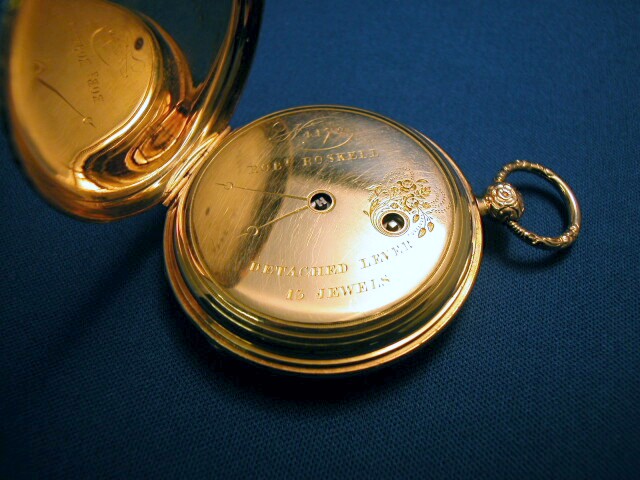 | ||||
|
Movement. Large jewels ("Liverpool windows"?), side lever, I can't see enough of the pallets to know if they are jeweled, solid rim with three pairs of timing screws on the balance wheel  | ||||
|
Case appears to be solid gold, I can't find a hallmark anywhere on it. The back is decorated with a hunting scene: a stag and two dogs. The decoration looks three-dimensional but is not. 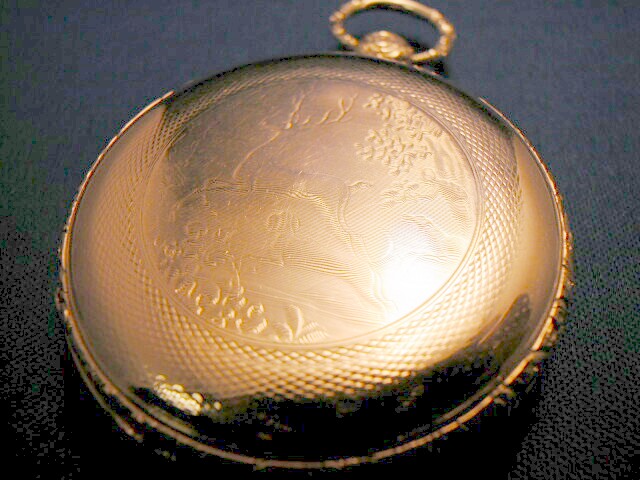 | ||||
|
| Powered by Social Strata | Page 1 2 |
| Your request is being processed... |
|
©2002-2025 Internet Horology Club 185™ - Lindell V. Riddle President - All Rights Reserved Worldwide

